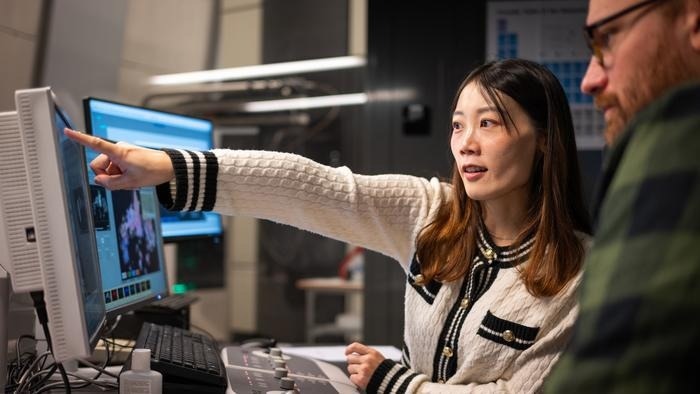Extremely thin materials, only a few atoms thick, have special qualities that make them desirable for water purification, catalysis, and energy storage. Now, scientists at Sweden's Linköping University have created a technique that makes it possible to create hundreds of novel 2D materials. The research was published in the journal Science.
 Jie Zhou, Assistant Professor at Linköping University. Image Credit: Olov Planthaber.
Jie Zhou, Assistant Professor at Linköping University. Image Credit: Olov Planthaber.
The field of study for incredibly thin materials, or 2D materials, has grown rapidly since the discovery of graphene. The explanation for this is that, compared to their volume or weight, 2D materials have a large surface area.
As a result, 2D materials exhibit a variety of unique characteristics and physical phenomena, including high strength, heat resistance, and good conductivity, which are valuable for both fundamental research and practical applications.
In a film that is only a millimeter thin, there can be millions of layers of the material. Between the layers, there can be a lot of chemical reactions and thanks to this, 2D materials can be used for energy storage or for generating fuels, for example.
Johanna Rosén, Professor, Department of Materials Physics, Linköping University
MXenes is the name of the largest family of 2D materials. A three-dimensional parent material known as the MAX phase is used to create MXenes. It is made up of three distinct elements: X is either carbon or nitrogen, A is an element of the (A-group), and M is a transition metal.
A two-dimensional material is produced by exfoliating or eliminating the A element with acids. As of right now, MXenes is the only material family produced in this manner.
A theoretical technique for forecasting additional three-dimensional materials that might be appropriate for transformation into two-dimensional materials has been presented by the Linköping researchers. Additionally, they have demonstrated the consistency of the theoretical model with reality.
The researchers employed a three-step procedure to be successful. To determine which parent materials would be appropriate, they first created a theoretical model. From a database and a selection of 66,643 materials, the researchers were able to identify 119 promising 3D materials using large-scale calculations at the National Supercomputer Centre.
Trying to make the material in the lab was the next step.
Out of 119 possible materials, we studied which ones had the chemical stability required and which materials were the best candidates. First, we had to synthesize the 3D material, which was a challenge in itself. Finally, we had a high-quality sample where we could exfoliate and etch away specific atom layers using hydrofluoric acid.
Jie Zhou, Assistant Professor, Department of Physics, Linköping University
Two-dimensional Ru2SixOy was formed when the researchers extracted yttrium (Y) from the parent material YRu2Si2.
However, in step three, verification is required to validate success in the lab. The Arwen scanning transmission electron microscope at Linköping University was utilized by the researchers. It is capable of analyzing materials and their atomic structures. In Arwen, spectroscopy can also be used to look into the individual atoms that make up a material.
We were able to confirm that our theoretical model worked well and that the resulting material consisted of the correct atoms. After exfoliation, images of the material resembled the pages of a book. Amazingly, the theory could be put into practice, thereby expanding the concept of chemical exfoliation to more materials families than MXenes.
Jonas Björk, Associate Professor, Division of Materials Design, Linköping University
The researchers' discovery signifies that numerous additional 2D materials possessing distinctive properties are now within grasp. They can then serve as the basis for an endless number of technological applications.
The researchers' next course of action is to expand the experimentation and investigate additional promising precursor materials. Future applications, in Johanna Rosén's opinion, are practically limitless.
Johanna Rosén concludes, “In general, 2D materials have shown great potential for an enormous number of applications. You can imagine capturing carbon dioxide or purifying water, for example. Now it is about scaling up the synthesis and doing it in a sustainable way.”
Journal Reference:
Björk, J., et al. (2024) Two-dimensional materials by large-scale computations and chemical exfoliation of layered solids. Science. doi.org/10.1126/science.adj6556
Source: http://www.liu.se/